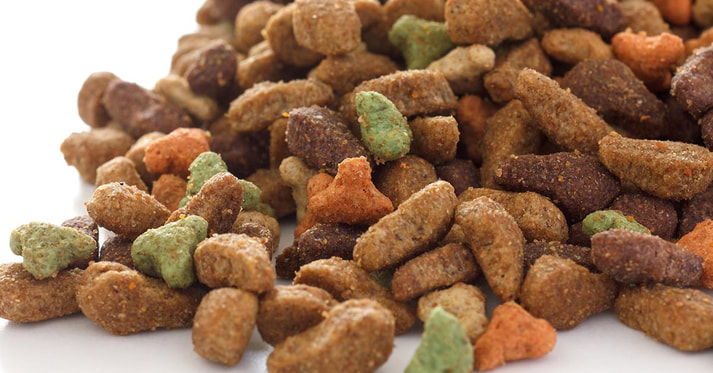|
Kibble is still the number one seller when it comes to pet food in North America, and while there are certain grades of kibble, from your run of the mill to premium, can it ever and will it ever be a ‘species appropriate diet’? Will your pet every really and truly thrive on it? I get asked this all the time, and here is my answer; no.
While there are many reasons, here are my top three reasons why: 1. It is dry: With a species appropriate diet, i.e. when your dog or cat catches a bird, a mouse or say a rabbit, the first thing they consume is blood. Blood as you know, is very wet, which then assists to lubricate the GI tract and get the digestive process flowing, so to speak. A species or biologically appropriate diet contains a moisture content at about 60% give or take, with kibble you are getting roughly around 6-7% moisture content. That is a huge gap! Not only is kibble dry as a rock, it actually pulls moisture from your pet’s GI tract making it even harder for them break down and assimilate nutrients from an already non-bioavailable form of food. When your dog or cat is lapping up water from their water dish that is a sure sign of dehydration, not a good thing, as it’s very taxing on their liver and kidneys. 2. Too high in carbohydrates: In a previous blog I gave an equation where you can calculate the carbohydrate/sugar content in your pet’s food, the ones who did it came back shocked, and it didn’t matter whether the food was bought from a veterinarian or grocery store. Carbohydrate content in kibble can range anywhere from 40%-55%+. That is just simply way too high, half or almost half of the pet’s food is compromised of non-essential simple sugars. I personally do not feed or sell any diet with a carbohydrate content over 15%-20%, and that is coming from fruits and vegetables (good sources). Especially for our feline friends, who should only be on a balanced protein diet with little to no carbohydrates at all, as they are obligate carnivores (meat only). Canines and felines are not designed like herbivores to break down high carbohydrate content, carnivores are made completely opposite to herbivores, with short and acidic digestive tracts meant to consume raw fresh meat. That is why they get bloated and gassy on kibble, and overtime excessive inflammation can lead to numerous health problems which can get quite expensive to treat. 3. Highly processed: I’m known for the saying, “If I take broccoli (which we all know by now is a superfood), batter it up and deep fry it, can I still claim it to be a health food?”. Well, same goes for kibble, no matter what health ingredient the manufacturer claims it has, it is too processed to ever be considered a health food (think steak that has been cooked to death), so what’s left of it? If you were to go see your doctor and he/she told you that from now on you only have to eat this special type of cereal that comes straight from a box and it is all balanced for you vitamin/mineral wise so you absolutely need to eat nothing else day in and day out, what would your reaction be? Mine would be thanks but no thanks, I like my carrots and apples and steak and chicken and salads, etc. You get the point. Now think of your pet, who has no choice in the matter, only eating what you put in the bowl, even though they get bloated and gassy but it might be mild enough so you don’t notice, meanwhile they are always eyeballing your food and why wouldn’t they?! It’s real food! In order for kibble to be kibble, it has to go through an extrusion process that uses heat and high pressure to create the shape and volume of kibble, that is how it’s manufactured. While there are the lesser of evils, it still is a high stretch to say that is what they were meant to consume. If one is still skeptical all they need to do is look at stool samples of a raw fed dog or cat and kibble fed. With raw feeding stools are smaller with practically no odor, the proof is always in the pudding! Tip to kibble feeders: Hydrate your pets’ food to add moisture back either with warm water or better yet, bone broth. Also, supplement with a good quality probiotic and digestive enzyme to better help your pet digest the high starch and carbohydrate content in kibble, as they lack the enzymes to digest the incomplete amino acids in foods like peas and corn. Adding things like kefir and other whole foods to accompany kibble is also a good way for your pet to safely get some form of bioavailable fresh foods into their diet. We at Thrive4life Holistic Pet offer ‘kibble toppers’ to better add more bioavailable nutrition to your pet’s diet, or if you want to switch your pet off of kibble and to a less processed species appropriate diet such as cooked, raw or a type of raw diet that has the convenience of kibble but the nutrition of raw, contact us to learn more.
0 Comments
Leave a Reply. |
AuthorLucy is an avid pet mom; with dogs, cats, goats and horses to keep her busy! All of her pet 'kids' are fed a species appropriate diet with proper supplementation so she can watch them thrive. Her expertise and experience lie in nutraceutical supplementation and is a health advocate for proper diet and nutrition. Her other passions in life are schutzhund and equestrian riding. Archives
July 2024
Categories |



 RSS Feed
RSS Feed